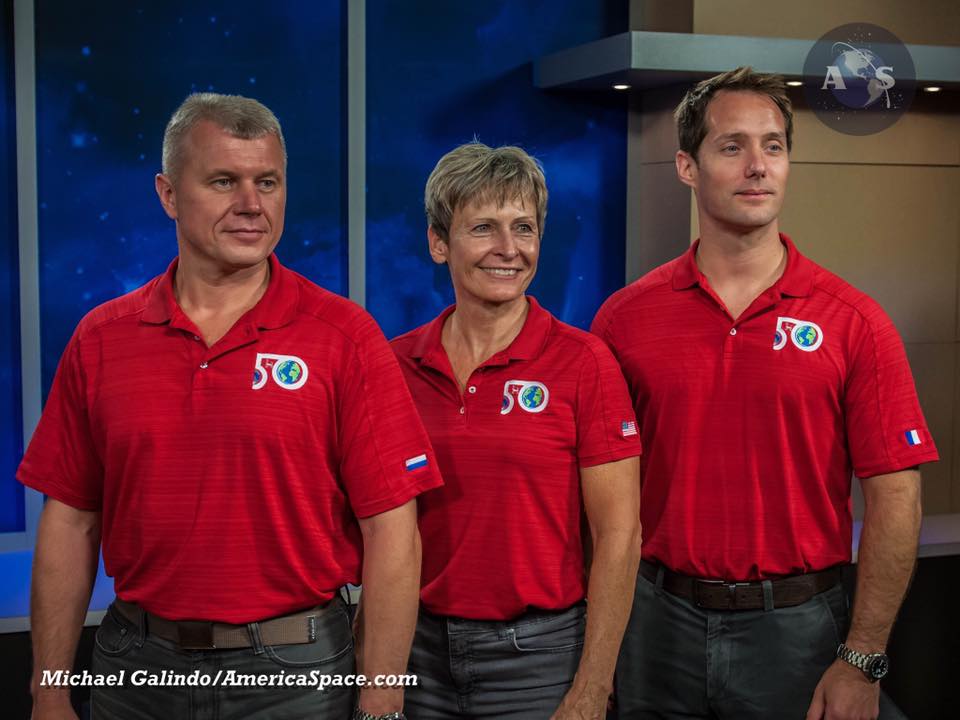
The world’s most experienced female space traveler, France’s 10th national astronaut, and a highly decorated Russian Air Force colonel are destined to form the second half of the 50th expedition to the International Space Station (ISS) in November. Former NASA Chief Astronaut Peggy Whitson and her crewmates Thomas Pesquet of the European Space Agency (ESA) and Oleg Novitsky of Russia will launch from the Baikonur Cosmodrome in Kazakhstan aboard their Soyuz MS-03 spacecraft, shortly after the 16th anniversary of the start of continuous occupation of the multi-national orbiting outpost. Yesterday (Tuesday, 30 August), the trio gathered at the Johnson Space Center (JSC) in Houston, Texas, to discuss their six-month mission, which may see Whitson become the most seasoned U.S. spacefarer and should leave Pesquet as the second most experienced French astronaut in history.
According to current projections, Whitson and her crew will launch from Baikonur’s Site 1/5 (“Gagarin’s Start”) on 16 November and are expected to follow a four-orbit “fast rendezvous” profile to reach the space station, docking at the Earth-facing (or “nadir”) Rassvet module about six hours later. Although most Soyuz missions since March 2013 have followed the fast rendezvous regime, there have been a number of exceptions. The Soyuz TMA-12M crew were forced to revert to a two-day profile, following a malfunction in March 2014 and, more recently, both the Soyuz MS-01 and MS-02 crews were assigned two-day profiles in order to carry out tests of their spacecraft systems, including the ability to communicate through Russia’s Luch-5 tracking and data-relay satellite network for up to 70 percent of each orbit.
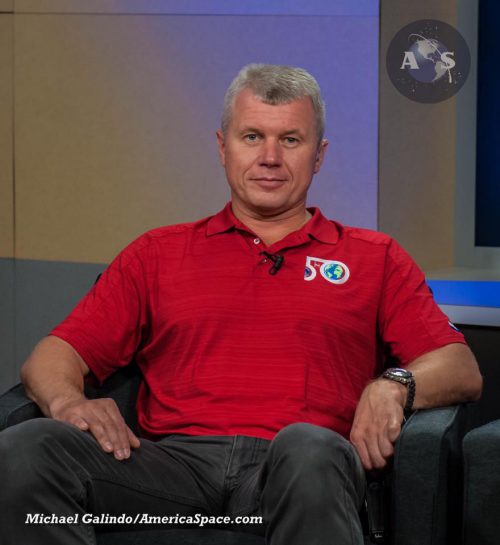
For launch, Novitsky will occupy the center seat, commanding Soyuz MS-03’s flight to and from the space station. In keeping with tradition, the crew has adopted its commander’s callsign; in this case, “Kazbek.” Another tradition is the carriage of a soft toy or doll, to serve as a “gravity indicator” and highlight the onset of weightlessness. Previous crews have taken up toys offered by their children, ranging from the “Frozen” character, Olaf, to a fluffy pink-and-white owl. Asked by AmericaSpace’s Michael Galindo if a gravity indicator had been chosen, Novitsky explained with a chuckle that he had not yet had a chance to think about it, since his schedule had been too tight. However, with only one child—Novitsky’s daughter—between all three crew members, it remains to be seen from where the inspiration for a gravity indicator will come.
Born in the Belarusian town of Chervyen in October 1971, Novitsky graduated as a pilot-engineer from the Kachin Higher Military Aviation School and served for 10 years as an attack and air-defense pilot for the Russian Air Force. Following a two-year spell in the Air Force Academy and further military assignments, he was selected for cosmonaut training in October 2006. Interestingly, two of Novitsky’s classmates will meet him in orbit: Sergei Ryzhikov will welcome him aboard Expedition 50 in November, whilst Aleksandr Misurkin and Nikolai Tikhonov will arrive at the ISS in March 2017 to form the second half of Expedition 51.
After two years of training and evaluation, Novitsky served as Russia’s director of operations at the Johnson Space Center (JSC) in Houston, Texas, before being named in early 2010 as a crew member for Expedition 33/34. Together with his Russian crewmate Yevgeni Tarelkin and NASA astronaut Kevin Ford, he launched aboard Soyuz MS-06 in October 2012 and the trio went on to log over 143 days in space. By this stage in his career, Novitsky had retired from the Russian Air Force, with the rank of a lieutenant-colonel, and in August 2015 he was assigned to a new crew with Whitson and Pesquet. “Flight is the pinnacle of training,” he told the audience, adding that the experience of actually riding a rocket into space is the “utmost achievement we can have.”
Seated to Novitsky’s left side aboard Soyuz MS-03 will be Pesquet, who was born in Rouen, France, in February 1978. After graduating from the competitive French “classes préparatoires aux grandes écoles” at the Lycée Pierre Corneille in Rouen, he completed a master’s degree, with a specialization in spacecraft design and control. He subsequently worked for Thales Alenia Space on satellite systems and later with the French national space agency, before graduating from Air France’s flight school in 2006. Pesquet flew as an Airbus 320 commercial pilot, before being selected as an astronaut candidate by the European Space Agency (ESA) in May 2009. He was assigned to Expeditions 50/51 in March 2014 and the complete crew was formally announced in August 2015. Although Pesquet is making his first flight, he has learned a great deal from his experienced crewmates. “Peggy’s built the space station by herself,” he joked, “and Oleg’s done a little bit, too!”
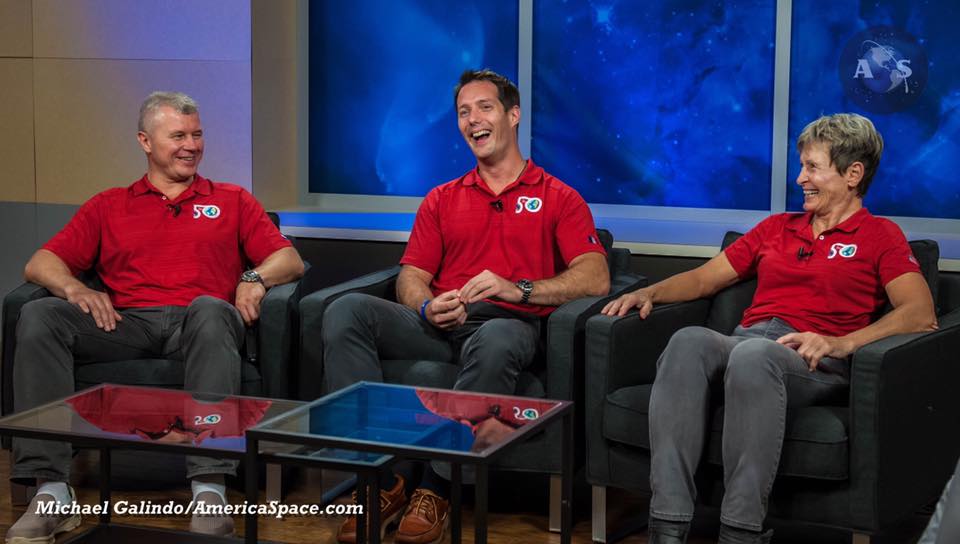
The right-hand seat aboard Soyuz MS-03 will be occupied by Whitson, who will begin her third space mission with a cumulative total of over 377 days from two previous long-duration ISS expeditions. Born in February 1960 in Mount Ayr, Iowa, Whitson will break Shannon Lucid’s record to become the oldest woman ever to travel into orbit, passing her 57th birthday whilst she is aboard the station. Whitson earned a degree in biology and chemistry in 1981 and attended Rice University, receiving her doctorate in biochemistry in 1985. She later joined NASA as a research biochemist and by the mid-1990s had been appointed as Project Scientist of the shuttle-Mir program. Selected by NASA in May 1996, she served as a flight engineer on Expedition 5 in June-December 2002 and subsequently became the first woman to command a space station increment when she led Expedition 16 from October 2007 through April 2008. During these missions, Whitson also performed six EVAs, accruing more than 39 hours in vacuum. By the end of her second flight, she had positioned herself as the most experienced U.S. astronaut, the most experienced female spacefarer in history, and the most experienced female spacewalker. Even today, she retains the top spot for the most experienced female spacefarer in history.
A year after returning from Expedition 16, in September 2009 Whitson was appointed Chief of the Astronaut Office, replacing Steve Lindsey. She completed a three-year tenure, during which time she oversaw the retirement of the shuttle fleet, a rapid downsizing of the astronaut corps, and the beginnings of Commercial Crew. Whitson was replaced by Bob Behnken in July 2012 and was widely considered a contender for the first One-Year mission. However, that assignment ultimately went to Scott Kelly and in summer 2015 Whitson was formally announced as a crew member for Expeditions 50/51. In keeping with the current ISS training template, they initially pulled backup duties for Anatoli Ivanishin, Kate Rubins, and Takuya Onishi on Soyuz MS-01, who launched to the ISS in July 2016.
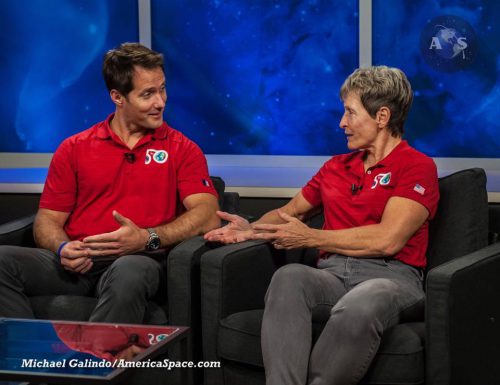
With around 11 remaining weeks left until launch, the training is coming to an end. They completed their emergency training last week and, whilst in Houston, Whitson and Pesquet are currently undertaking robotics work and have one more EVA simulation in the Neutral Buoyancy Laboratory (NBL). After that is complete, Novitsky and Pesquet will depart for Russia in September for six to seven weeks of final training on Soyuz-MS and Russian Orbital Segment (ROS) systems. “A pretty busy time for us in the next few weeks,” was Whitson’s summary as they close in on their 16 November launch date.
Upon their arrival at the ISS, Whitson, Novitsky, and Pesquet will be welcomed by incumbent Expedition 50 Commander Shane Kimbrough of NASA and his Russian flight engineers Sergei Ryzhikov and Andrei Borisenko, who will have been in orbit since late September. If all runs to schedule, their increment as the second half of Expedition 50 and, from February 2017—under Whitson’s command—as the “core” of Expedition 51 will see the arrivals or departures of two SpaceX Dragons, one Orbital ATK Cygnus and three Russian Progress craft. The crew should also see as many as two U.S. EVAs in the spring 2017 timeframe and the relocation of Pressurized Mating Adapter (PMA)-3 from its current perch on the Tranquility node to the space-facing (or “zenith”) port of the Harmony. This will await the arrival of International Docking Adapter (IDA)-3 in early 2018 to provide a backup interface for Commercial Crew vehicles.
Following the departure of Kimbrough, Ryzhikov, and Borisenko in late February 2017, Whitson will rotate into the command of Expedition 51, becoming the first woman to lead two space station increments. In mid-March, the crew of Soyuz MS-04—consisting of Russian cosmonauts Aleksandr Misurkin and Nikolai Tikhonov, together with NASA astronaut Mark Vande Hei—will arrive to restore her crew to its full six-person strength. According to Novosti Kosmonavtiki, Whitson’s crew will return to Earth on 15 May 2017, wrapping up 180 days in orbit.
And if this date holds, Whitson will soundly surpass Jeff Williams, the current U.S. spaceflight endurance record-holder, who is expected to reach a career total of 534 days in orbit when he returns to Earth on 6 September. She will return home with 557 days across her three-mission career, which will place an American citizen—for the first time since 1983—within the Top Ten list of the world’s most flight-experienced spacefarers. In fact, sitting at about No. 8 by the time she lands, Whitson will have spent a cumulative 18.5 months of her 57 years of life away from the Home Planet.
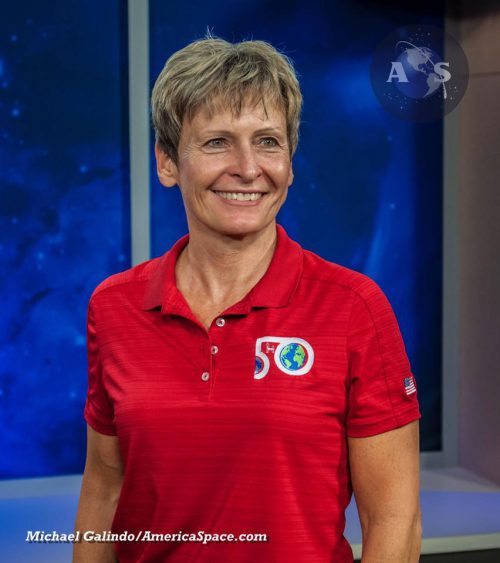
However, by her own admission, Whitson is not seeking records. “It’s not about the individual,” she said. “We do what we have to for the program.” That said, Whitson will become only the third American to chalk up three long-duration missions. Asked by AmericaSpace’s Michael Galindo about changes to the Astronaut Office’s policy on cumulative radiation exposure, she was philosophical. Policy limits, she explained, remain unchanged and are dependent upon the amount of days spent in orbit, the sex and age of the specific crew members, whether or not a particular mission was undertaken during a high-radiation period or if any EVAs were conducted. However, Whitson acquiesced that the future—and particularly NASA’s plans to someday achieve a human landing on Mars—will require changes and greater risk will need to be embraced and accepted.
As the 10th French astronaut (or spationaute), Pesquet blazes a trail which extends back to the pioneering voyage of his countryman Jean-Loup Chretien to the Soviet Union’s Salyut 7 space station in June 1982. Chretien boasted the additional accolade of performing France’s first EVA on a second flight in the fall of 1988, whilst Claudie Andre-Deshays became the first French woman to undertake a space mission in the summer of 1996. By this time, spationautes had spent periods of up to three weeks in orbit, but it was the six-month voyage of Jean-Pierre Haignere in February-August 1999 which began to cement France’s long-duration credentials. Added to a previous, 20-day mission to Mir, Haignere currently stands as the most experienced French spacefarer to date, with over 209 days in orbit.
If Thomas Pesquet’s expedition runs to its timeline of 180 days, he will position himself—by default—as the second most experienced spationaute of all time. In discussion with AmericaSpace’s Michael Galindo, he noted that he had met the other nine French spacefarers and found that they all had much in common. However, Pesquet considers it heartening that the 1980s mentality of single-mission scenarios is no longer the norm, with the space station and specifically Europe’s Columbus lab on-orbit. In particular, he highlighted that there is much more opportunity for “Europeans” to be selected as part of a wider research program with the station fully built and operational.
Indeed, with such an enormous international partnership behind the ISS Program, it has become customary at each of these press briefings to see representatives of several sovereign countries. Whitson described the Expedition 50/51 trio as “an adaptable crew” and several questions pressed them on the cultural differences and their personal perspectives on traveling into space. Initially, Pesquet joked that the main difference was the food, whilst Whitson stressed that learning the Russian language was particularly difficult for her. Summing up, Pesquet explained that the best way of learning “is to get out of your comfort zone” and that, although academic success is important, the need to work as part of a team, empathize with others, and understand one’s colleagues is crucial.
That “understanding” may also extend to Pesquet’s desire to fly a saxophone to the station. By his own admission, it is an instrument he played in his youth and he was careful to stress that if the opportunity presented itself he would find a quiet corner of the station to play. At this point, Whitson piped up that, if he wasn’t a good sax player, she and Novitsky would certainly let him know.
Want to keep up-to-date with all things space? Be sure to “Like” AmericaSpace on Facebook and follow us on Twitter: @AmericaSpace




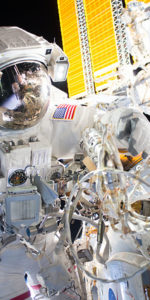
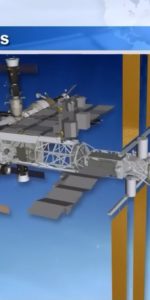
“Policy limits, she explained, remain unchanged and are dependent upon the amount of days spent in orbit, the sex and age of the specific crew members, whether or not a particular mission was undertaken during a high-radiation period or if any EVAs were conducted. However, Whitson acquiesced that the future—and particularly NASA’s plans to someday achieve a human landing on Mars—will require changes and greater risk will need to be embraced and accepted.”
And what is the scientific, coldly logical, and important national security interest, or reason, the NASA radiation policy limits have to be changed and “greater risk will need to be embraced and accepted”?
Is it because a President, who doesn’t seem to like the idea of NASA leading international human Lunar surface missions, is bored with the Moon and thought it would enhance his ‘legacy’ if he somehow attached his name to future human Mars missions?
Is it because NASA isn’t going to anytime soon receive the funding from Congress that is needed to build spacecraft with the effective radiation shielding required for long duration Mars missions?
Is it because we are in some undeclared new Cold War and have to prove how ‘tough’ and technologically sophisticated we are by some certain date?
“To quote the Technical Panel’s final briefing to the entire NRC Committee in 2013, ‘In the current fiscal environment, there are no good pathways to Mars.'”
And, “It might be better to stop talking about Mars if there is no appetite in Congress and the Administration for higher human spaceflight budgets, and more disciplined execution by NASA. (And further relative reductions of NASA’s science budgets are neither a plausible answer, nor responsible, given the fact that the findings from the Earth Science, Planetary Science, and Heliophysics programs offer far more practical benefit to humanity than does a program of human exploration, especially one that does not show significant progress relative to what we have seen before). At a minimum, we should agree on a pathway that is satisfying to the public, even if it does not lead to Mars in the foreseeable future. A pathway that includes the surface of the Moon is one obvious possibility.”
From: Testimony submitted by John Sommerer: ‘Charting a Course: Expert Perspectives on NASA’s Human Exploration Proposals’
Press Release From: House Committee on Science, Space, and Technology
Posted: Wednesday, February 3, 2016
At: http://spaceref.com/news/viewpr.html?pid=47821
There appears at this time to be no real logical national security reason, or geopolitical priority, for Congress to support costly NASA human Mars missions and their unneeded high radiation and other spaceflight risks, does there?
On the Moon there is lots of regolith that can act as effective Galactic Cosmic Radiation shielding if it is piled six meters deep on top of habitats. The Moon also has lots and lots of readily available iron. About a meter and a half of iron might also be effective radiation shielding.
Maybe we are going to wisely keep our current NASA human mission radiation limits and join with other nations in developing and using the many resources of the Moon to continue the affordable development of the very valuable and useful region known as Cislunar Space.
“There is no ‘Journey to Mars’ except in the minds of some agency bureaucrats. The supposed three-stages of the ‘Journey’ – low Earth orbit (LEO), the cislunar ‘proving ground,’ and traveling to Mars – hypes new technology and capability development, exemplified by the existing LEO phase featuring missions to the International Space Station (ISS); missions currently gathering data on long-term spaceflight, particularly in terms of deconditioning of the human body. But the time required for a round-trip to Mars will not be simulated; the recent ‘Year in Space’ by astronaut Scott Kelly covers roughly only a third of the expected total duration of a human Mars mission.”
From: ‘Not Vaunted, Not Clever and Not Working – The State of America’s Space Program’
By Paul Spudis September 4, 2016
At: http://www.spudislunarresources.com/blog/
If you want highly partisan and politicized public relations pap, listen to NASA’s leadership and Elon Musk when they pontificate on their fantasies about how we are getting ready to soon go to Mars.
If you want reality, read what Paul Spudis and others write about why developing the resources of the Moon makes much more sense.